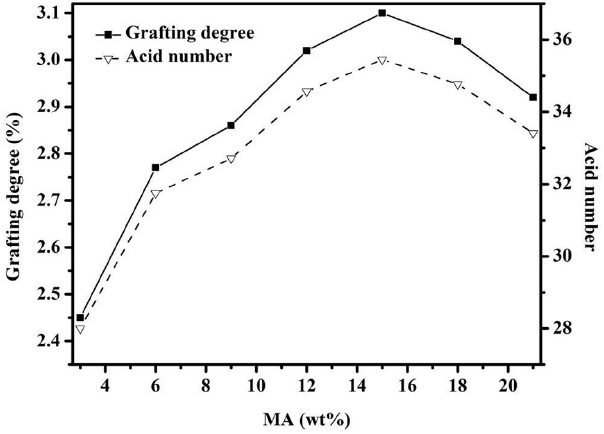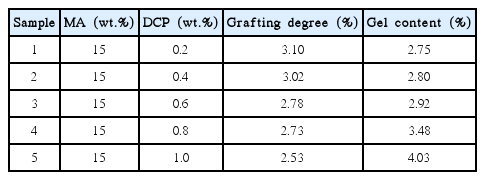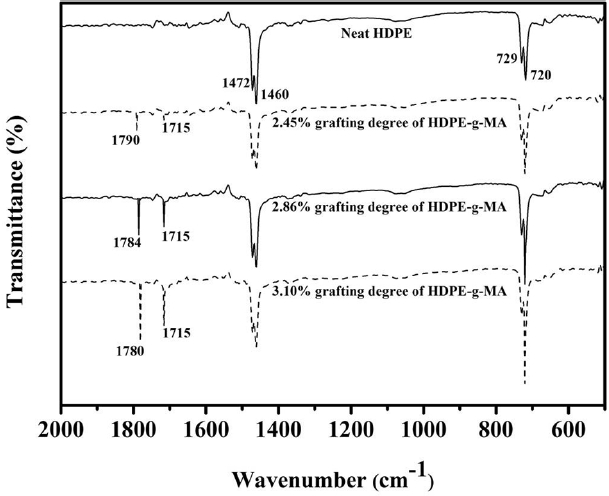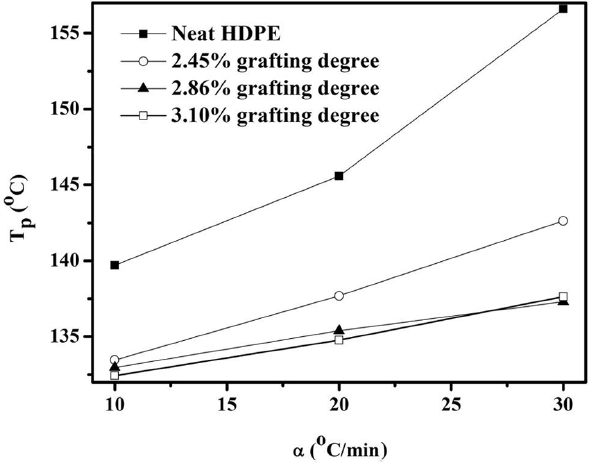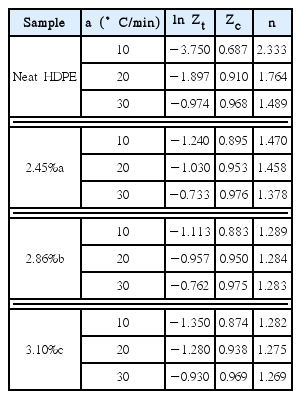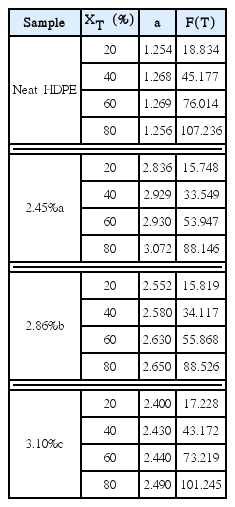Synthesis and Non-Isothermal Crystallization Behaviors of Maleic Anhydride onto High Density Polyethylene
Article information
Abstract
The grafting reaction for maleic anhydride (MA) onto high density polyethylene (HDPE) was investigated from solution process with initiators. The chemical modification of neat HDPE was carried out with various contents of MA (3–21 wt.%) and initiator (0.2–1 wt.%) at different temperature (80–130°C). The grafting degree was obtained from the titration and the highest grafting degree was 3.1%. The grafting degree increased as the content of MA and initiator increased, however, the highest grafting degree was demonstrated for a particular content of MA and initiator. In the non-isothermal crystallization kinetics, the Ozawa model was unsuitable method to investigate the crystallization behavior of MA onto HDPE, whereas the Avrami and Liu models found effective. The crystallization rate was accelerated as the cooling rate increased, but postponed by combination of MA onto neat HDPE backbone.
1. Introduction
Polyethylene (PE) is an extensively used polymer with an excellent mixture of physical and chemical properties and low cost. These qualities have stimulated its wide application in industries that involve packing, bottles, and films. However, the non-polarity of PE has limited its use in applications. 1) To overcome this shortcoming, which limits its current usage, PE modified different monomers has been studied.2–9) Functional reactions have been proposed using maleic anhydride (MA),10) acrylic acid (AA),11) vinyl acetate (VA),12) and ethyl acrylate (EA)13) to improve the properties of PE. These functionalized products are used in several applications, such as agents to improve the chemical compatibility or coupling, impact modifiers, anticorrosive coatings for metal pipes, and multilayer sheets of PE and polypropylene (PP).14,15) In recent years, the crystallization behaviors of functional polymers as a function of processing conditions are of great important. The ultimate properties of polymer composites are known to greatly dependent on the degree of crystallinity.16) Furthermore, PE is a typical crystallizable polymer. From the standpoint of engineering interest and the academic aspect, knowledge of the crystallization behavior of PE is necessary because of the need for the property investigation.17,18) Therefore, research into the kinetics of the crystallization behavior is essential to determine appropriate processing conditions of polymers.19)
The study of the non-isothermal crystallization of polymers is of technical significance, because most functional treatment techniques are performed under non-isothermal conditions.20–22) Moreover, in terms of the functional aspect, non-isothermal crystallization is more effective than the isothermal crystallization because most treatment techniques generally take place under non-isothermal conditions.22) The non-isothermal crystallization kinetics of PE and its composites has been widely studied in the literature,23–33) but few publications have been found the non-isothermal crystallization kinetics of MA onto high density polyethylene (HDPE-g-MA). Because of this, research should be undertaken to study the non-isothermal crystallization kinetics of HDPE-g-MA.
In this study, for the first time, a detailed investigation of the synthesis of HDPE-g-MA, and a consideration of its effects on the non-isothermal crystallization behavior of neat high density polyethylene (HDPE), HDPE-g-MA were studied thoroughly. The melt method of the grafting reaction has several advantages including short reaction time and no solvent. However, due to the side reactions at high temperature, the grafting degree is low.32) This experiment was carried out using a solution process for the grafting reaction of HDPE-g-MA. The grafting degree of MA and their interactions in HDPE matrices have been characterized by FTIR and the titration method. The non-isothermal crystallization kinetics was also determined using different models, including the models of Ozawa, Avrami and Liu et al.
2. Experimental Procedure
2.1 Materials
High density polyethylene (HDPE, d ≈ 0.958 g/cm3) with melt index and tensile strength of 0.25 g/10min and 300 kgf/cm2 was supplied by LG Chem (Korea). Dicumyl peroxide (DCP, 98%), benzoyl peroxide (BPO, 75%) and 2,2′-azobisisobutyronitrile (AIBN, 99%) as free radical initiators and maleic anhydride (MA, 98%) as monomer were purchased from Sigma-Aldrich (USA). Xylene (80%) as a solvent and acetone (99.5%) as a wash for products were purchased from Daejung Chem (Korea).
2.2 Grafting of maleic anhydride onto HDPE
The grafting reaction of HDPE-g-MA was performed via solution process in a four neck flask equipped with an impeller, thermocouple, and reflux condenser. In a typical experiment, 30 g of HDPE was dissolved in 300 mL of xylene by heating to the desired temperature via a heating mantle. When the HDPE was completely dissolved, a chosen amount of MA was added in the flask. Then, selected amount of initiator dissolved in 50 mL of xylene was added to the reaction flask. The reaction continued for 240 min and the sample was precipitated into 300 mL of acetone for 24 h at room temperature. After that, the sample was recovered and washed with a purifying solvent such as xylene and dried at 60°C under vacuum for 24 h to remove unreacted MA.
2.3 Grafting degree of maleic anhydride onto HDPE
Purified HDPE-g-MA (0.3 g) was dissolved in 100 mL of xylene and the solution was titrated to a thymol blue end point using potassium hydroxide in ethanol (0.1 N). Grafted samples were completely soluble and did not precipitate during titration. The grafting degree was calculated using the acid number.
2.4 Gel content of maleic anhydride onto HDPE
Using soxhelt extraction process for 24 h with xylene as a solvent at 120°C, the gel content of crosslinked sample was determined, according to ASTM D 2765. An approximately 0.3 g weighted sample was cut into small piece and placed in a pre weighted stainless steel with wire mesh. After the extraction process, the sample was washed with acetone and dried under vacuum to a constant weight. The gel fraction was calculated as the percentage ratio of final weight of the product to its initial weight.
2.5 Fourier transform infrared spectroscopy (FTIR)
FTIR spectra on a Nicolet IS10 were used to demonstrate the functional groups of neat HDPE and HDPE-g-MA. During the measurement, an attenuated total reflection (ATR) mode was used. The spectra were measured with an average of 50 scans and a resolution of 2 cm−1.
2.6 Differential scanning calorimetry (DSC)
The non-isothermal crystallization kinetic measurements were carried out with a TA instruments Q500 DSC. The samples were dried under vacuum at 80°C for 24 h to remove remaining water. Approximately 5 mg of the sample was weighted in the aluminum pan and placed in the DSC cell. The non-isothermal crystallization of neat HDPE and HDPE-g-MA were performed as follows: The samples were heated to 200°C at a rate of 10°C/min under a nitrogen atmosphere and held for 10 min to destroy residual nuclei. Then the samples were cooled to 100°C at a heating rate of 10°C/min. The non-isothermal crystallization behaviors were studied by cooling samples from 200°C to 100°C at a constant cooling rate of 10, 20, 30°C/min, respectively. The exothermal curves of heat flow as a function of temperature were recorded to investigate non-isothermal crystallization kinetic and crystallinity of the samples was affected from the heat of crystallization.
3. Results and Discussion
3.1 Grafting of MA onto HDPE
The effects of MA concentration on the acid number and the grafting degree are shown in Fig. 1. The grafting degree was calculated according to the following equations (1), (2):
where VKOH and NKOH are the consumed volume (mL) and the equivalent concentration (N) of potassium hydroxide in ethanol, respectively. WgHDPE is 0.3 g of HDPE-g-MA. At 15 wt.% of MA against of HDPE and 0.2 wt.% of DCP as initiator at 120°C, the grafting degree was obtained up to 3.1%. After this, the grafting degree decreased with increasing MA concentration. If the monomer concentration is high, the number of monomers that reaches the backbone will increase, but the grafting reaction is limited because the number of macro-radicals is determined by the constant amount of initiator. Moreover, the high concentration of MA can cause homopolymerization and consume the radicals.34) We suggest that the grafting degree is controlled by the number of monomers that attack the backbone when the monomer concentration is not too high.
The effect of the initiator on the grafting degree was studied (Fig. 2). The grafting reaction of HDPE-g-MA was carried out using three types of free radical initiators, namely DCP, BPO, and AIBN. The results indicate that the grafting degree mostly increased with increasing the concentrations of BPO and AIBN, but not DCP. It is well known that the grafting reaction is competitive reaction which depends on the amount of free radical.35) Furthermore, this may be partly due to the half-life of the initiators. The half-life of initiators can be considered regarding the residence time of reactants during the grafting reaction. The initiators with a shorter half-life can generate more radicals, more termination reactions take place by recombination of radicals, and decrease grafting degree.36) Moreover, AIBN as initiator with very short half-life is unsuitable to increase grafting degree because the cyanoalkyl radicals formed show little tendency that occur via hydrogen abstraction.
The gel content of HDPE-g-MA as DCP is presented in Table 1. The grafting reaction always indicates a side reaction, in which the initiator radical excites the HDPE chain through hydrogen abstraction. A higher amount of initiator (0.4 wt.%) may affect all of the free radicals that generated the greater crosslinking. Moreover, Ganzeveld et al..37) reported that crosslinking increased with increasing of the MA and the initiator concentrations. This can lead to an increase in the gel content due to the presence of macro-radicals of HDPE caused by the excimer or by the peroxide interaction of HDPE. Thus, we found that the grafting degree decreased with increasing gel content because macro-radicals of HDPE precipitated in crosslinking during the grafting reaction.
3.2 Influence of reaction temperature of MA onto HDPE
The reaction temperature was found to have a great effect on the grafting degree. In general, a higher temperature can cause an increased reaction speed, such as quicker initiator decomposition. However, a higher temperature does not appropriately induce a higher grafting degree because most initiators have a certain temperature and time of decomposition. 37) For solution process, the grafting reaction will be dependent on the reaction time, prolonging the reaction time may not be useful for increasing the grafting degree because of polymer backbone decomposition.38)
The highest grafting degree was achieved at 120°C (Fig. 3). When the reaction temperature was lower or higher than 120°C, the grafting degree decreased. This was similar to investigations by Shen et al.39,40) and Ku Marsilla et al.41) who studied the difference grafting degree at reaction temperature between 130 and 200°C. In other study, Clark et al.1) showed the grafting reaction when using styrene as a co-monomer when grafting MA onto various polyethylenes. Moreover, the grafting degree can have been related to the half-life of the initiator. The half-life of DCP is 439.09 min at 115°C (the constant difference of decomposition rate is 2.63 × 10−5 s−1) 240.58 min at 120°C (the constant difference of decomposition rate is 4.80 × 10−5 s−1), and 133.82 min at 125°C (the constant difference of decomposition rate is 8.63 × 10−5 s−1). The higher temperature caused decreased the grafting degree because of the quicker decomposition of DCP, which may have led to some unreacted radical, quickly terminated the grafting reaction. The lower temperatures also led to a reduction of the grafting degree due to the slower decomposition of DCP, which may have led to some radical formation. The above observations suggest that a time of 240 min at 120°C is suitable for DCP to substantially attack the HDPE backbone.
3.3 FTIR spectra of MA onto HDPE
Generally, the FTIR spectra have been extensively used to identify functional groups of polymers.42–44) In this study, FTIR data of neat HDPE and HDPE-g-MA were showed in Fig. 4. The spectra of HDPE-g-MA indicated two absorbance peaks at 1715 and 1790–1780 (1790, 1784, 1780) cm−1 while they were absent in the neat HDPE. The absorption at 1715 cm−1 was investigated from carbonyl stretching of the carboxylic acid group, the absorptions at 1790–1780 cm−1 were revealed from symmetric and asymmetric stretching of the carbonyl in MA. This was similar to results by Samay et al.,45) Kozel et al.46) that carboxylic acid (1750–1660 cm−1) and anhydride (1830–1750 cm−1) were used to verify of MA onto PE. Furthermore, the absorptions of carbonyl at 1790–1780 cm−1 were shifted to lower wavenumber with increasing the grafting degree (Fig. 4), which was similar to results of MA onto PE and MA onto SBS.47,48) These results meant that particular intermolecular or intramolecular hydrogen bonds were formed when the hydrogen proton of the carboxyl group acted as the electron accepter, while the oxygen atom of the anhydride acted as the donor. Because of this, the increased hydrogen bonds may induce increasing the grafting degree. Thus, to investigate effect of grafting degree on the crystallization, the non-isothermal behaviors will be included in the next section.
3.4 Non-isothermal crystallization behavior
The research of non-isothermal crystallization behavior is significant because most of the current processing treatments of polymer accompany the non-isothermal crystallization process. The crystallization behavior of neat HDPE and HDPE-g-MA from the melt at three cooling rates of 10, 20, 30°C/min was studied using DSC. The data in Fig. 5 indicate the non-isothermal crystallization of neat HDPE and HDPE-g-MA at 20°C/min of cooling rate. Some effective conditions for the non-isothermal crystallization from these curves can be seen such as the onset temperature of crystallization (To), the crystallization temperature as the highest exothermic peak (Tp) and the finishing temperature (Tf). The crystallization temperature (Tp) and the percent crystallinity (Xc) of neat HDPE and HDPE-g-MA are presented in Table 2. The percent crystallinity (Xc) of neat HDPE and HDPE-g-MA was determined by following equation:

Crystallization Temperature and Crystallinity of neat HDPE and HDPE-g-MA for Cooling Rates of 10, 20 and 30°C/min
where the value of the heat of crystallinity of neat crystalline HDPE (ΔHc) was investigated to be 293 J/g.49) From DSC thermograms at cooling rates, it is evident that the crystallization peak temperature, for neat HDPE is higher than those of HDPE-g-MA and increases with increasing cooling rates. As is known, the faster cooling rate occurs the shorter time stayed at all temperature to progress crystallization from the melt, and therefore the crystallization procedure is restricted.50) The plots, which indicate the variation of the peak temperature with cooling rates, for the neat HDPE and HDPE-g-MA are shown in Fig. 6. It is suggested that the peak temperature at a given cooling rate decreases with increasing the grafting degree.
3.5 Non-isothermal crystallization kinetics
In order to further analyze the non-isothermal crystallization process, the crystallization kinetics of 2.45% and 3.10% grafting degree of HDPE-g-MA was compared (Fig. 7). The relative crystallinity as a function of crystallization temperature, XT, was calculated by following equation.51–53):
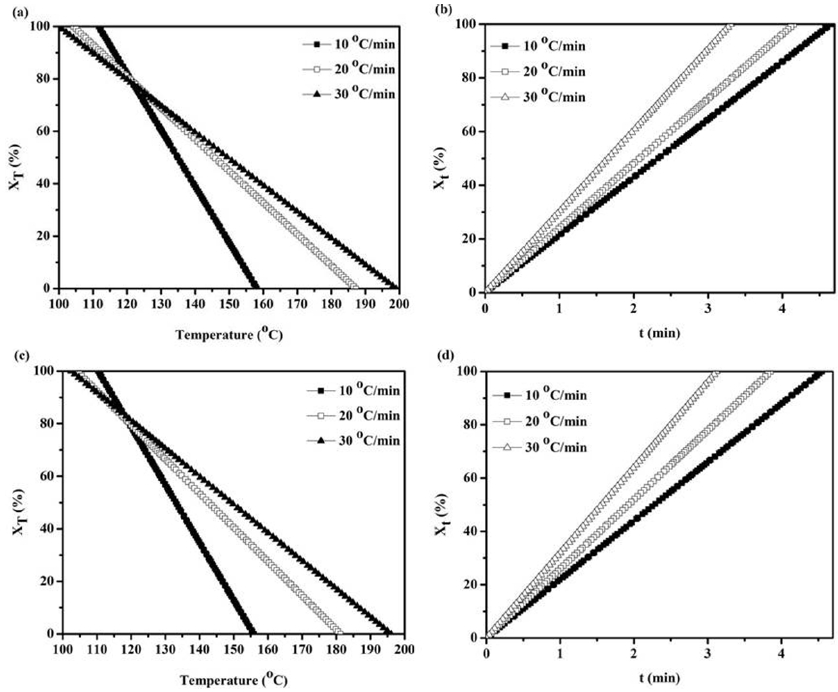
Relative degree of crystallinity (a) temperature and (b) time for crystallization of 2.45% grafting degree at different cooling rates, (c) temperature and (d) time for the crystallization of 3.10% grafting degree at different cooling rates.
where To and Tf are the onset and finishing crystallization temperature, and dH/dT is the heat flow rate. The 2.45% and 3.10% grafting degree of HDPE-g-MA of relative degree of crystallinity XT as function of temperature were shown by various cooling rates (Fig. 7(a), (c)). The plots of XT versus T for HDPE-g-MA are similar. In non-isothermal crystallization, the crystallization time can be related to crystallization temperature by using the following equation:
where To is the onset temperature of crystallization behavior and α is the cooling rate. According to Eq. (5), the value of horizontal T-axis can be transformed into the crystallization time (Fig. 7(b), (d)). It can be seen that the higher the cooling rate, the shorter the time for completing the crystallization behavior.
The half crystallization time (t1/2) is explained as the half period at Xt = 50% from the onset of crystallization and the end of crystallization. The t and t1/2 values of neat HDPE and HDPE-g-MA can be investigated from Fig. 8, Fig. 9, Fig. 10, and the results are presented in Table 3. It is displayed that the value of t1/2 decreases with increasing cooling rate. Furthermore, the t1/2 value for HDPE-g-MA is lower than that for neat HDPE and mostly decreases with increasing grafting degree. These results demonstrate that t1/2 value for HDPE-g-MA can decrease due to chain branching of HDPE-g-MA, MA as monomer may serve as nucleating agent to facilitate the overall crystallization process.
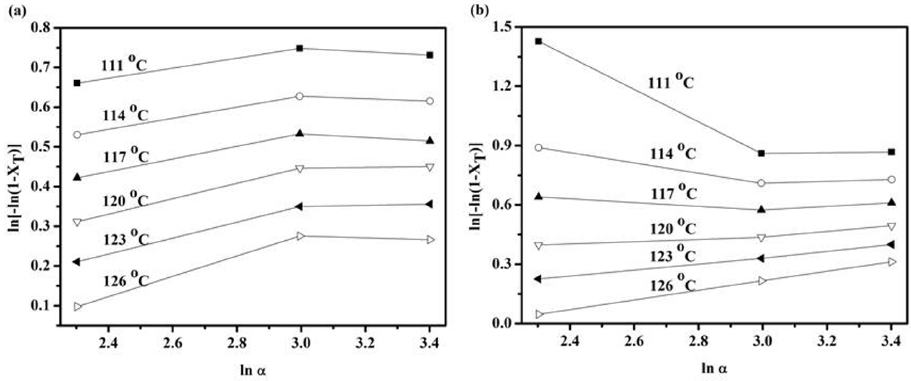
Ozawa plots of ln[−ln(1−Xt)] versus ln α for (a) neat HDPE, and (b) 3.10% grafting degree HDPE-g-MA during non-isothermal crystallization process.

Avrami plots of ln[−ln(1−Xt)] versus ln t for (a) neat HDPE, and (b) 3.10% grafting degree of HDPE-g-MA during non-isothermal crystallization process.
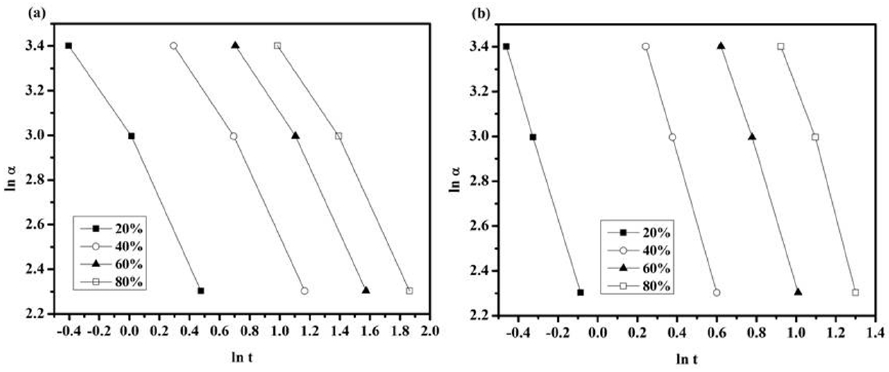
Liu plots of ln α versus ln t for (a) neat HDPE, and (b) 3.10% grafting degree of HDPE-g-MA during non-isothermal crystallization process.

Non-isothermal Crystallization Parameters Tp, To, t, and t1/2 for Neat HDPE and HDPE-g-MA at Various Cooling Rates
For the analysis of the experimental results of neat HDPE and HDPE-g-MA under non-isothermal crystallization, the Ozawa, the Avrami and the Liu models were applied to describe the non-isothermal crystallization kinetics of neat HDPE and HDPE-g-MA.
3.6 Non-isothermal crystallization kinetics by using the Ozawa model
The Ozawa equation54) has been used for investigating the non-isothermal crystallization of polymer.55–58) According to this model, the degree of conversion at temperature T, XT, can be written as a function of cooling rate:
where K(T) is the cooling crystallization function, α is the cooling rate and m is Ozawa exponent that depends on the dimension of crystal growth. The Eq. (6) can be rearranged for following equation:
Researching the process at different cooling rates and plotting ln[− ln (1 − XT)] against ln α at a given temperature, a straight line should be obtained if the Ozawa model is valid, and parameters of m and K(T) can be investigated from the slope and intercept, respectively. Ozawa plots of neat HDPE and HDPE-g-MA are displayed in Fig. 8. The crystallization behaviors of neat HDPE and HDPE-g-MA are not fitted wee with Ozawa model due to the curvatures in the plots. The reason for this problem is that, ignored factors in the Ozawa model are dependent on the folded length of the polymer chain on temperature59) and also a function of both time and cooling rate for crystallization process.60) Therefore, the Ozawa model was investigated to be unsuitable for the non-isothermal kinetic of HDPE-g-MA.
3.7 Non-isothermal crystallization kinetics by using Avrami model
The Avrami model54,61) is widely applied in identifying the isothermal crystallization kinetics of many polymers. According to the Avrami model the relative degree crystallinity at a time t, Xt, can be determined by following equation:
where n is the Avrami exponent and Zt is the crystallization rate constant involving both nucleation and growth rate parameters. Eq. (8) can be rearranged in its double logarithmic form as:
By fitting ln [−ln(1 − Xt )] versus ln t for each cooling rate, a straight line would be obtained and the values of n and Zt can be determined from the slope and intercept of the plots (Fig. 9). It should be noted that n and Zt in non-isothermal crystallization do not have the same physical importance as in the isothermal crystallization because the temperature changes constantly during non-isothermal crystallization. Regarding the non-isothermal feature of the process described, Jeziorny62) indicated that Zt of the rate parameter should be corrected by cooling rate α of the polymer. The parameters of the non-isothermal crystallization kinetic were given by following equation:
where Zc is the corrected kinetic rate constant. The results obtained from the Avrami plots and the Jeziorny method are presented in Table 4. In general, the Avrami exponent relates to be affected by the molecular weight, nucleation type, and secondary crystallization. The values of the Avrami exponent for neat HDPE were higher than that for HDPE-g-MA at a given cooling rate, indicating that HDPE-g-MA has simpler nucleation mechanism. Moreover, we may suggest that HDPE-g-MA is more easy crystal growth and it is more stable than neat HDPE. It could be showed that for all samples the values of Zc increased with increasing the cooling rate (Table 4), which signified an increase of crystallization rate.
For a given cooling rate, Zc for HDPE-g-MA was higher than that for neat HDPE, suggesting that HDPE-g-MA has a faster crystallization rate than neat HDPE. This can be investigated by the enhanced mobility of the polymer chains because of the grafting reaction.
3.8 Non-isothermal crystallization kinetics by using Liu model
Liu et al.63) proposed a method by combining the Ozawa and Avrami model to investigate the non-isothermal crystallization kinetics which is useful in many polymers.64–66) The relationship between the cooling rate α and the crystallization time t at a given degree of crystallinity can be defined as:
At a given crystallinity Xt, Eq. (11) can be rearranged to
where F(T) = [K(T)/Zt]1/m relates to the value of cooling rate, which must be selected at unit crystallization time when the determined systems have a certain degree of crystallinity, a = n/m, the ratio of Avrami exponent n to Ozawa exponent m. F(T) can be seen a definite physical and functional meaning. The kinetic parameters F(T) and a were determined from the intercept and slope of the lines, respectively. Plots of ln α versus ln t at various degree of crystallinities for neat HDPE and HDPE-g-MA are displayed in Fig. 10. The values of a and F(T) are presented in Table 5. It can be seen that the plots show a good linear relationship between ln α and ln t, signifying clearly that Liu model described the non-isothermal crystallization kinetic of neat HDPE and HDPE-g-MA. The values of F(T) and a increased with increasing in the relative degree of crystallinity. For a given degree of crystallinity, a higher value of F(T) signifies that a higher cooling rate is needed to acquire this relative degree of crystallinity within unit crystallization time, indicating the difficulty of crystallization process. As the relative degree of crystallinity increased, it was showed that the values of HDPE-g-MA were lower than those of neat HDPE. These demonstrated that the crystallization rate of HDPE-g-MA was faster than that of neat HDPE, as the same analysis of Zc in Avrami model. Thus, based on this experiment, when PE-g-MA was added to the heavy oil, the functional groups can inhibit paraffin crystals from aggregation.32) PE-g-MA as compatibilizer can enhance the interaction of inorganic material and the polymer.67) This is significant for various applications of PE-g-MA as a compatibilizer.
4. Conclusions
The aim of this study was to investigate the synthesis of HDPE-g-MA, which was prepared by solution process, and the effect of the grafting reaction on the non-isothermal crystallization behavior. HDPE-g-MA was successfully produced using the solution process. The grafting reaction was found to depend on the interaction between the monomer concentration, the type and concentration of the initiators, the temperature, and the half-time. HDPE-g-MA was found to investigate functional groups and the grafting degree, FTIR spectra and titration method provided direct evidence. In non-isothermal crystallization kinetics, it was found that the Ozawa model was rather unsuitable, possibly because of the incorrect presumption concerning secondary crystallization. In comparison, the Avrami plots indicated good linearity and were able to describe non-isothermal crystallization kinetic. The Jeziorny method investigated the non-isothermal crystallization process of neat HDPE and HDPE-g-MA with analysis of Liu model. The crystallization rate was accelerated as the cooling rate increases, but postponed by combining the MA onto neat HDPE backbone.
Acknowledgments
This work was supported and funded by the Korea Institute of Energy Technology Evaluation and Planning (Grant No. 2013T100100021) through grant funded by the Korean Government.
